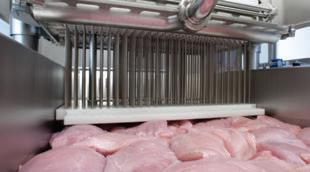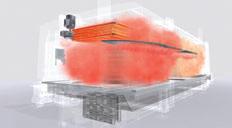
7 minute read
Tech Perspective
AARON HAND | EDITOR-IN-CHIEF
GEA explains how replacing a traditional tumble-cook process with an inject-tumble-cook process, along with its latest-generation spiral oven, produces yield boosts of up to 10%.
GEA INTRODUCED its first CookStar—a double-spiral, two-zone oven—back in 1992, when fully cooked products were gaining popularity with consumers and fast food was beginning to take hold in Europe. Through the years, the equipment supplier has made upgrades to the CookStar line, such as improvements in capacity and airflow, an impingement zone, and three-phase cooking.
Its latest generation, the CookStar 1000, released last year, includes an improved heat exchanger technology that generates up to 25% more heating capacity. In a recent webinar, not only do GEA’s experts detail the workings of the new oven, they explain the science behind the benefits of adding an extra injection step before cooking meat in the oven. Yields are improved by locking in juice marinades and by fast and precise cooking.
The physics behind water binding
To fully understand the arguments for the best way to inject the meat with brine, GEA first took some time to explain the importance of the brine itself and how it is applied.
“You receive your raw material in the factory, and you have your muscle in there. But on top of that, you have plenty of drip—that is the lack of water holding capacity,” explains Victoria Metaute, a GEA food technologist focused on the marination process. “The holding capacity is the viability of the meat to be able to sustain all the natural water through all the processes that you are going to put that meat through.”
Of key importance is the pH balance of the meat. There will be a natural pH loss in the meat—and the more that pH level drops, the more water you will lose from the meat, Metaute explains. “That is very much attached to your end yield,” she says.
To avoid pH depletion, the earlier you process the meat, the better. Keeping the pH well controlled between 5.5 and 6 will keep your protein ligaments completely entangled, and will give you the spaces you need to insert the brine or to hold natural moisture.
But also important is how the ingredients of that brine are combined. With water as the base, typically salt and phosphates are added. Those are functional ingredients that work well together, but the order of their addition is not trivial and is also not well understood, according to Metaute. “For example, I’m making my brine and I’m having my water, and now I put my salt, and after that I dissolve it, and I put my phosphate in. Later on, there are some stones in there. And that is the problem that is going to happen. You’re going to have undissolved functioning ingredients that are going to mess with your yield at the end of the process.”
Instead, Metaute recommends adding the phosphate to the water before the salt. “Give it the time for it to be completely dissolved, and after that will be your salt,” she says. “Those two together will improve your pH. It will be increased and it will be out of the electrostatic point—where you’re actually running out of water.” Beyond that, you can add your other ingredients, such as starches and fibers, which will help hold moisture in.
PHOTO COURTESY OF GEA
For poultry brine injections, GEA recommends 2 mm injection needles with its MultiJector system for better brine distribution that does not destroy the structure of the meat.
s The GEA CookStar 1000 industrial spiral oven o ers an improved heat exchanger design and optimized horizontal and vertical airflow.

PHOTO COURTESY OF GEA
Injection technology
Injecting the meat before tumbling speeds up the process and generates more capacity in your tumblers, reiterates Bart Leenders, product specialist in marination for GEA. He explains the GEA MultiJector technology used for the process. “If we combine physics and state-of-the-art equipment, we can end up with 6% extra yield during a process if you compare it with the traditional way, by tumbling only,” he says. “If you only tumble, you do not use all the water binding capacity of your meat.”
Adding the injection step distributes the brine much more evenly and quickly to the whole piece of meat—not only at the surface, but also into the core. “By that, the customer ends up with a nice and juicy piece of meat,” Leenders adds.
For poultry, GEA recommends a 2 mm needle. “If you compare it with a 3 mm needle, you’ve got the benefit that it creates some small needle holes that easily close, and you keep the brine inside,” Leenders says. “With that small needle pattern, you’re creating way more injection spots as with a wide 3 mm pattern.”
Also important is what GEA calls its Time-inMeat technique—a linear movement with a constant speed. “In a common process, your needle stroke is quite long, so the time is limited that it is in the meat. Some equipment is already able to adjust the height to certain positions; you create a little bit longer time in the meat,” he explains. “What we can do with our equipment is that we can adjust the height just above the meat. With the maximum time in meat, we can inject with lower pressures. Lower pressures mean less damage of your structure and better water binding capacity.”
Third-generation CookStar
To take the 6% yield improvement gained by the injection step up to 10% factors in use of the CookStar 1000, where GEA uses a three-zone cooking concept that combines horizontal and vertical air speeds.
“Cooking is all about having control over your parameters. In the CookStar, we have a set of three parameters that we control,” says Luuc van Landveld, product manager for GEA. “First of all, there’s the temperature. We can control the temperature in two zones independent from each other. We can go as high as up to 250°C and we can go down in the other zone. So we can have a di erential temperature between the two zones of up to 150°C.”
The second parameter is the dewpoint. “We use the moisture in the oven—the steam—to transfer the latent heat to the product. Also there, we can control the dewpoint independent from each other. We can go as high as 95°C and as low as 45°C.”
Finally, GEA controls the speed of the air in the zones. “We can do it over the horizontal zones anywhere between 1 and 7 m/s,” van Landveld says. “And then in the booster impingement zone, we can go up as high as 35 m/s.”
GEA uses all of these parameters to optimize settings for customers’ cooking processes. The results they have seen are significant. “We compared a purely horizontal oven with our three-zone turbo CookStar,” van Landveld says. “What you see in the first zone, you normally use the latent heat of the steam to bring up the temperature. But then you need to set color because the steam doesn’t set any color. So, you need to cook on temperature to get color. What is di erent on the CookStar is that we use this booster impingement zone in the middle. What we do is we hit the product with fast-moving hot air. So we kind of blow-dry the surface and the surface only; we don’t want to lose any yield in the core. Now that we did the surface treatment, we actually need far less time to develop even more color. So basically, what you end up with is a shorter cooking time and having a more brown coating.”
With spiral ovens, there is often a temperature di erence over the width of the belt, causing users to overcook their product to compensate for the worst part of the belt. Instead, GEA came up with a way to reduce the temperature di erence over the width of the belt to only 1.5°C. “That enables us to really reduce the need for overcooking. So bottom line, it gives you better yields and shorter cooking times.”
Ultimately, combining the injection step before cooking creates a succulent chicken with improved yield. The GEA MultiJector locks in marinades, while the CookStar 1000 oven cooks fast and with precision.
GEA
www.gea.com








